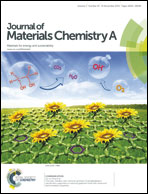Controllable wettability and adhesion on bioinspired multifunctional TiO2 nanostructure surfaces for liquid manipulation†
Abstract
Hierarchical surfaces with specific topographical morphology and chemical components can be found on many living creatures in nature. They offer special wettability and adhesion (sliding, sticky or patterned superhydrophobic surfaces), a functional platform for microfluidic management and other biological functions. Inspired by their precise arrangement of structures and surface components, we described a facile one-step electrochemical technique to create dual-scale hierarchical anatase TiO2 structures with the combination of pinecone-like micro-particle upper layers and dense-stacked nanoparticle bottom layers in a large scale. The as-prepared TiO2 films display environment-responsive wettability with good dynamical stability. Extremely high contrast of adhesion (2.5–170 μN) can be realized by simply adjusting the physical structures (anodizing voltage and electrolyte concentration dependent) to control the solid–liquid contact state (from “Rose” to “Lotus” state). In addition, erasable and rewritable patterned superhydrophobic TiO2 films were constructed for a versatile platform for microfluidic management. In a proof-of-concept study, robust super-antiwetting films for on-demand droplet separation, mixing and transportation under an ambient atmosphere or an underwater environment, and patterned superhydrophobic surfaces for liquid self-assembling or anti-counterfeiting marks were demonstrated.


 Please wait while we load your content...
Please wait while we load your content...